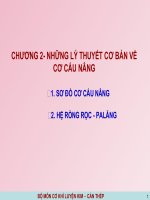Nuclear Magnetic Resonance 2 doc
Bạn đang xem bản rút gọn của tài liệu. Xem và tải ngay bản đầy đủ của tài liệu tại đây (575.15 KB, 14 trang )
1
Lecture Date: February 13
th
, 2008
Nuclear Magnetic Resonance 2
NMR Experiments
NMR experiments fall into some basic categories:
– Basic pulse methods
Single pulse
Selective pulse or selective decoupling
Solvent suppression
– 2D and multi-dimensional experiments
unravel complex spectra by separation of overlapping signals,
control of “mixing” between signals (to obtain more data)
– Multiple resonance (heteronuclear techniques)
Are often 2D or nD sequences
– Diffusion, dynamics and relaxation experiments
2
Common Solution-state NMR Experiments for
Organic Structural Analysis
Experiment Acronym
Information
Provided
GASPE
DEPT
Gated-spin echo
Distortionless editing by
polarization transfer
13
C multiplicity
(C, CH, CH
2
, CH
3
)
COSY correlated spectroscopy
1
H-
1
H covalent
bonding, 2-4
bonds
HMQC heteronuclear multiple
quantum coherence
1
H-
13
C covalent
bonding, 1 bond
HMBC heteronuclear multiple
bond correlation
1
H-
13
C covalent
bonding, 2-4
bonds
NOE difference,
NOESY,
ROESY
nuclear Overhauser
effect spectroscopy
1
H-
1
H proximity in
space, 1.8-4.5 A
Pulse Sequences
Modern NMR involves flexible spectrometers that can
implement pulse sequences, which are designed to
extract and simplify relevant information for the
spectroscopist
Designed to harness a property or properties of the
nuclear spin Hamiltonians
– J-coupling
– Chemical shift
– Quadrupolar coupling
– Dipolar coupling
Or, are designed to measure a bulk effect
– Relaxation
– Diffusion
– Chemical exchange or dynamics
3
Basic Pulse Sequences
A single pulse and acquire
An Example of 1D NMR
Top – 1H spectrum
Middle – Selective pulse
Bottom – homonuclear decoupling
4
Multi-dimensional NMR
The general scheme of 2D and multi-dimensional NMR:
Evolution (t
1
) Detection (t
2
)Preparation Mixing (t
m
)
Experiment Time
2D NMR data has two frequency dimensions:
Can include NOE or J-
coupling mixing
FT(t
1
) FT(t
2
)
A Simple 2D NMR Spectrum
Diagonal Peak
Cross peak
(“correlation”)
1
2
3
4
5
12345
F
1
(ppm)
F
2
(ppm)
5
An Example of 2D NMR – the COSY Experiment
Correlations are
observed between
J-coupled protons!
(Example is a sample
of sucrose in D
2
O)
Applications of NMR
Structural analysis
Quantitative analysis
Stereochemical and conformational analysis
Solid-state analysis
6
Structural Analysis –
13
C NMR and Editing
13
C spectra of
cholesteryl acetate:
(a) continuous
1
H
decopling
(b)
1
H during
acquisition (no
NOE)
(c) GASPE (APT)
(d) DEPT-135
Structural Analysis:
1
H –
13
C Correlation
The
1
H-
13
C HSQC
analysis of
clarithromycin:
7
Structural Analysis: Long-range
1
H –
13
C Correlation
The
1
H-
13
C HMBC
analysis of
carvedilol:
Structural Analysis:
1
H –
15
N Correlation
The
1
H-
15
N long-
range HMQC
analysis of
telithromycin:
8
Determination of Relative Stereochemistry
NOE difference spectroscopy
Determination of Absolute Stereochemistry
Remember the ring
current effect?
J. A. Dale and H. S. Mosher, J. Am. Chem. Soc., 95, 512-519 (1973).
C. E. Johnson and F. A. Bovey, J. Chem. Phys., 29, 1012 (1958).
Chemical Shie lding around the Benzene Ring
-2
0
2
4
6
8
10
12
0.0 2.0 4.0 6.0 8.0
Distance from Ring Ce nte r (A)
Absolute Isotropic Shielding (ppm)
Abov e Ring
In Ring Plane
Chemical Shie lding around the Benzene Ring (Expande d View)
-1
-0.8
-0.6
-0.4
-0.2
0
0.2
0.4
0.6
0.8
1
4.0 5.0 6.0 7.0 8.0
Dis tance from Ring C enter (A)
Absolute Isotropic Shielding (ppm)
Above Ring
In Ring Plane
shielding (opposes field)
deshielding (aligned with field)
9
Determination of Absolute Stereochemistry by
Mosher-Dale Method
Procedure: Derivatize a chiral alcohol with MPTA, -methoxy--
(trifluoromethyl)phenyl acetic acid
Because a phenyl group’s deshielding effects drop off more rapidly with
distance than its shielding effects, protons close to a phenyl should be more
shielded!
Example: 5-nitro-2-pentanol
F
3
C
O
PhH
3
CO
O H
CH
3
(R)-alcohol
NO
2
(S)-MPTA-Cl
=> (R)-MPTA ester
1
2
3
4
4.45t
2.02m
1.69m
1.26d
5.15m
3.51q 7.4-7.5m
89
10
11
5
6
7
|
5
J
H9,F10
| = 1.2 Hz
|
3
J
H11,H5
| = 6.2 Hz
|
3
J
H2,H3
| = 6.9 Hz
|
4
J
H2,H4
| = 0 Hz
F
3
C
O
PhH
3
CO
O H
(S)-alcohol
H
3
C
(S)-MPTA-Cl
=> (R)-MPTA ester
1
2
3
4
4.34dt
1.83m
1.62m
1.35d
5.15m
3.55q 7.4-7.5m
89
10
11
5
6
7
NO
2
|
5
J
H9,F10
| = 1.1 Hz
|
3
J
H11,H5
| = 6.3 Hz
|
3
J
H2,H3
| = 6.8 Hz
|
4
J
H2,H4
| = 2.2 Hz
J. A. Dale and H. S. Mosher, J. Am. Chem. Soc., 95, 512-519 (1973).
A. Guarna, E. O. Occhiato, L. M. Spinetti, M. E. Vallecchi, and D. Scarpi, Tetrahedron, 51, 1775-1788 (1995).
19
F Quantitative Analysis: TFA Salt Stoichiometry
10
Solid-state Nuclear Magnetic Resonance
NMR in solids, like solution-state, relies
on the behavior of nuclear spin energy
levels in a magnetic field. However, the
interactions that affect NMR spectra act
differently.
In liquids, molecules reorient and
diffuse quickly, leading to narrow
isotropic resonances.
In solids, the fixed orientation of
individual crystallites leads to a range
of resonance frequencies for
anisotropic interactions.
E
m=+1/2
m=-1/2
No field
Field = B
0
E=(h/2)B
0
Solid-state NMR: Magic-Angle Spinning
These can be averaged away over
time by spinning at a root of the
scaling factor:
The result of magic angle spinning
(often combined with dipolar
decoupling):
1cos3 cos
2
2
P
broadening
E. R. Andrew, A. Bradbury, and R. G. Eades, Nature, 183, 1802 (1959).
I. J. Lowe. Phys. Rev. Lett. 2, 285 (1959).
The following anisotropic interactions
are dependent on their orientation
with respect to the large magnetic
field (B
0
):
– dipolar (homo- and heteronuclear)
coupling
– 1st-order quadrupolar coupling
– anisotropic chemical shift
11
Cross-Polarization
Cross-polarization is an example of a double resonance experiment
– Two resonances, typically two different nuclei, are excited in a
single experiment.
Cross-Polarization combined with MAS (CP-MAS):
– Enhancement of signal from “sparse” spins via transfer of
polarization from “abundant” spins
– The “Hartmann-Hahn condition” allows for efficient energy
transfer between the two spins, usually via dipolar interactions
– The basic CP pulse sequence for
1
H to
13
C experiments:
1
H
13
C
CP
CP
90
CW Decoupling
E. O. Stejskal and J. D. Memory. “High Resolution NMR in the Solid State,” Oxford University Press, New York (1994).
A. Pines, M. G. Gibby and J. S. Waugh. J. Chem. Phys., 59, 569 (1973).
An Example: Polymorphism in Carvedilol
13
C CP-TOSS spectra of the polymorphs of SKF105517 free base
Amorphous forms generally give broadened spectra
NH
O
NH
O
OH
O
H
3
C
1
2
3
45
6
7
8
9
10
11
12
13
14
15
16
17
1819
20
21
22
23
2
4
25
26
12
An Example: Polymorphism in Carvedilol
15
N SSNMR spectroscopy also shows similar effects.
Advantages: simple and easy-to-interpret spectra, valuable information
about the nitrogen chemical environment
Disadvantage: much lower sensitivity
NH
O
NH
O
OH
O
H
3
C
1
2
3
45
6
7
8
9
10
11
12
13
14
15
16
17
1819
20
21
22
23
2
4
25
26
Magnetic Resonance Imaging
• The basic idea: a linear magnetic field gradient imposes a
linear spread of Larmor frequencies on a sample.
Figure from S. W. Homans, A Dictionary of Concepts in NMR, Oxford, 1989.
For more details, see P. G. Morris, NMR Imaging in Medicine and Biology, Oxford University Press, 1986.
00
B
Gradient
00
B
13
Magnetic Resonance Force Microscopy
Rugar, D.; et al. Nature 2004, 430, 329–332.
R. Mukhopadhyay, Anal. Chem. 2005, 449A-452A.
A “combination” of
AFM and EPR (and
hopefully NMR)
Uses a nano-scale
cantilever to detect
spin motion
induced by RF via
in an magnetic field
Nuclear Spin Optical Rotation (NSOR)
Nature 2006, 442, 1021
Measures NMR signals by detecting phase shifts
induced in a laser beam as a the beam passes
through a liquid
Gives excellent spatial resolution
Currently lacks sensitivity
Developed by Romalis group at Princeton
14
Homework
19-10
19-15
Optional Homework
Also, please answer one of these based on the article you chose to read:
MRI: Describe the basic action of a field gradient on a sample. Also
describe how the spin-warp imaging method obtains a 2D image, and
why it is similar to conventional 2D NMR.
Solid-state NMR: What effect(s) in solid-state NMR spectra allow for the
analysis of hydrogen-bonding?
NMR-MOUSE: List the differences and similarities between unilateral low-
field NMR and traditional high-field NMR instrumentation. Why are T
2
measurements so analytically useful with this technique?
MRFM: Briefly describe the current AFM-derived devices used to detect
electron spins. What advances need to be made to take the technique
forward to nuclear spins?









